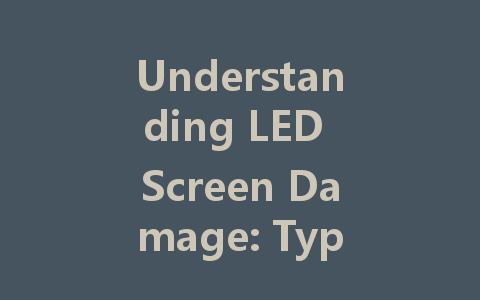
LED screens have become an integral part of our daily lives, found in everything from smartphones to large outdoor displays. While these screens are known for their vibrant colors and sharp images, they are not immune to damage. Understanding the different types of LED screen damage, their causes, and possible solutions can help you maintain your devices better and extend their lifespan.
What is LED Screen Damage?
LED screen damage refers to any defect or malfunction that affects the display quality of an LED screen. This damage can manifest in various ways, significantly impacting the screen’s functionality and user experience. Common symptoms include discoloration, dead pixels, flickering, or even total screen failure.
Types of LED Screen Damage
Physical damage is one of the most common types of LED screen damage. This can occur due to drops, impacts, or pressure. The consequences can range from minor scratches on the surface to complete shattering of the glass. Physical damage often requires repair or replacement, which can be both costly and time-consuming.
A dead pixel is a tiny dot on the screen that does not display any color. These pixels may appear black or different from the surrounding ones, disrupting the visual experience. Dead pixels can result from manufacturing defects or external factors like impact or high temperatures. While some dead pixels can be fixed through software solutions, others may require a screen replacement.
Burn-in occurs when static images remain on the screen for prolonged periods, causing a permanent ghost image to appear. This is more common in OLED screens but can occur in LED screens when bright logos, menus, or video game HUDs are displayed for too long. To prevent burn-in, it’s advisable to vary the content displayed and utilize screen saver functions.
Accidental spills and moisture exposure can lead to liquid damage. This type of damage compromises the internal components of the LED screen and may lead to malfunction or complete failure. If liquid damage occurs, it’s crucial to disconnect the device from power immediately and seek professional help to minimize the damage.
Color distortion refers to changes in color quality, where some colors may appear washed out or inaccurate. This can result from faulty components, improper settings, or damage. Troubleshooting color distortion often involves calibrating the display settings, but in severe cases, repair or replacement may be necessary.
Causes of LED Screen Damage
Understanding the causes of LED screen damage can help you take preventive measures. Here are some common culprits:
Excessive heat, humidity, and exposure to direct sunlight can accelerate degradation in LED screens. It’s important to place devices in well-ventilated areas away from direct sunlight to minimize these risks.
LED screens are sensitive and can be damaged by careless handling. Avoid placing heavy objects on top of devices or touching the screen with sharp objects. Always use protective cases when transporting devices with LED screens.
Sudden power surges can damage the internal components of an LED screen. Utilizing surge protectors can safeguard your devices against this threat.
Solutions to LED Screen Damage
To keep your screen in good condition, regular cleaning and maintenance are essential. Use microfiber cloths and non-abrasive cleaning solutions to clean the screen. Schedule periodic checks for any signs of damage.
For devices like smartphones and tablets, using a screen protector can prevent physical damage from scratches and impacts. Tempered glass protectors offer additional durability and can absorb shocks.
For severe damage, it’s best to consult with professional repair services. They have the tools and expertise to assess and fix the issues without causing further damage. Attempting to repair screens yourself could lead to worsened problems.
Conclusion
LED screens offer excellent visuals but are susceptible to various types of damage. By understanding the types of damage, potential causes, and effective solutions, you can enhance the longevity of your devices. Regular maintenance, careful handling, and timely repairs are crucial in protecting your LED screens from unexpected damage and ensuring a consistent, high-quality viewing experience. Whether it’s a smartphone, TV, or monitor, taking proactive steps will help you enjoy your LED screen for years to come.